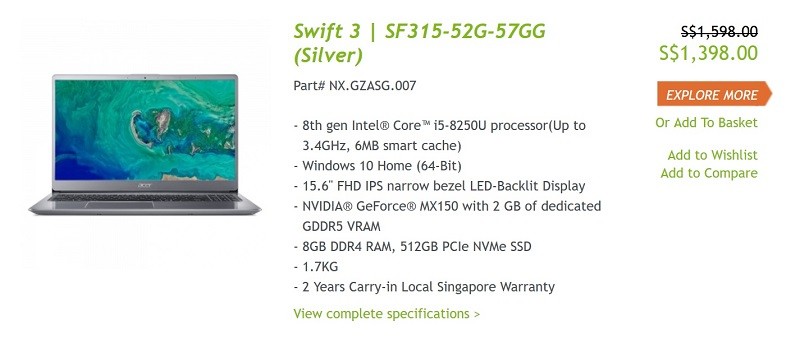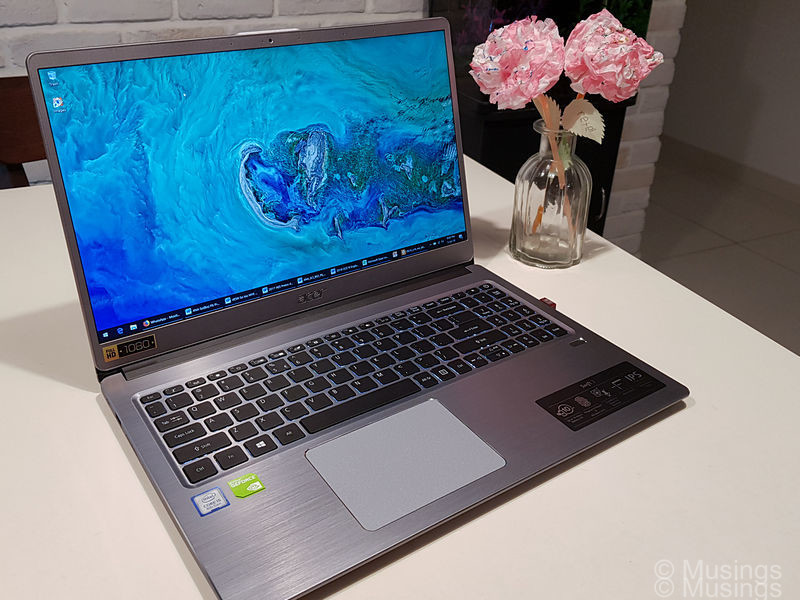The Dell XPS 13 that I bought 3.5 years ago experienced a critical component failure 6 months ago in January this year – right at about the three year mark. Specifically, its battery could no longer be detected, and the laptop could only be used with AC power. The laptop got re-homed to my parents’ place for my mom to get her Solitaire fix in between episodes when she binge-watched Chinese TV drama series. Yep, a state of the art laptop with killer performance and an extremely fast SSD used for Solitaire! Unfortunately, over the recent weekend, that XPS 13 finally suffered another catastrophic failure – it stopped booting up altogether. I didn’t have a spare laptop to go from our Minton home, so we decided to pass Ling’s HP Pavilion notebook to parents and I’d get her a new one.
The process of selecting a new laptop for the wife isn’t very different from the one I do annually: except that she has fewer requirements than I normally do. For example, geeks like myself will get picky about the display’s color gamut, viewing angles, keyboard flex, key travel, build quality, size of bezel, type of storage, whether the laptop has the FN and CTRL keys swapped around, type and number of ports, how the ports are placed around the chassis, what kind of AC charging it uses etc. On the other hand, the wife’s wanted a new notebook that had:
A screen that was as large as her HP Pavilion 15;
A number keypad;
A matte screen. She hates glossy screens LOL.
And that was it. Every other characteristic that usually ties up enthusiasts in knots the wife didn’t have any preferences for. She was happy to leave the research to me and go back to figuring out her next Thermomix recipe haha. Funnily, the wife never noticed any of the quirks on her Pavilion 15. And even after I pointed them out to her, she was nonplussed still.
On my end, the additional requirements I stacked on were:
At least 8GB RAM. Not an issue in this day and age, since there are very few notebooks on retail these days that come with less than 8GB RAM;
SSD as the primary storage device. The HP Pavilion 15 had sufficient system RAM and a decent i7 processor, but it was severely gimped from the beginning by a slow as molasses hard drive. Windows 10 boot-up times took way longer than they should;
A wide-angle and display capable of better contrast. The HP Pavilion 15 had a really bright screen nits-wise, but was otherwise deficient with narrow viewing angles, and a mostly washed out screen;
And hopefully, under $1.4K.
After a weekend of the usual exploration and seeing the models in person at the various Challenger/Denki/Harvey Norman stores, the choices came down to:
Xiaomi Mi Notebook Pro: beautifully crafted MacBook Pro clone, great specs, and available cheaply here at just $1.1K though only as export sets i.e. warranty-less. Doesn’t have a matte screen or number keypad. Also, comes with the Chinese version of Windows 10, but I can fix that.
Aftershock MX-15: great specs, easily exceeds the wife’s three requirements, and about $1.3K after configuration. None of the pre-installed bloatware found in most other manufacturers that I’d have to take time to clean-out too. Somewhat heavy though. And let’s face it: Aftershocks are more popularly known as game and technology enthusiast machines than for businesses or home users!
Asus S510 Vivobook: Fairly light, OK specs with i5/8GB RAM/256GB SSD. Screen is contrasty and supports wide-angles, but maximum brightness is rather low. Also, the test units I tried out at stores all showed some keyboard flex.
HP Pavilion 15: one of the final two contenders, alongside the Acer model below. Basically, an upgraded model in HP’s Pavilion 15 series. Comes with i5/8GB RAB/128GBSSD + 1TB HDD. Decent screen. Rather heavy with its hard plastic chassis, but there’s a great backlit keyboard with keys that have nice spring to it. Uses a last generation i7 Intel processor though.
Acer Swift 3 SF315: ultrabook-thin, very light for a 15.6″, aluminum for the top lid i.e. even more assuringly rigid than the Pavilion 15, uses the current 8th generation Intel i5 processor, and decent screen. Most importantly, a better storage inclusion – 512GB SSD.
The wife tried handling both of the latter two options, and instinctively preferred the Pavilion 15 on account of its slightly better keyboard. My preference was for the Swift 3. The build quality gave me more confidence, it was using the better processor, and also had more high-speed storage. Yeah it’s an Acer and many consumers will not want to go near the brand. But I’ve had no worse luck with Acers than other manufacturers (e.g. Dell and Apple, both of which I had laptops which suffered from major failures shortly after warranty ended). And the unit comes also with the standard 2 year warranty – as did also the Aftershock, Asus and HP options I was considering too.
Ling was OK to go with my recommendation of the Acer. So a quick purchase from Denki @ Parkway Parade and return home, the rest of the weekend was spent cleaning out all the rubbish Acer and Windows 10 puts on new notebooks, and installing the various productivity software the wife uses.


My initial overall impression is that the Swift 3 is a pretty decent machine indeed, and competitive for its $1.4K price-point. The screen doesn’t have very high-brightness – a common characteristic that I saw in the mainstream manufacturer 15.6″ notebooks at this price-point – but viewing angles are good, and the screen’s color seems to be correctly calibrated out of the box, unlike the Lenovo X1 Carbon. The all round thin screen bezels also make for a slightly smaller 15.6″ laptop compared to the others, and the keyboard is still adequate if not fantastic.
Interestingly, at no point did the laptop run warm during the couple of hours I was removing bloat and installing apps, nor did I hear the fans spin-up. The internal cooling, all metal build and fast processor probably helped a lot in that.
I’ll probably disassemble the now kaput XPS 13 to see if there’s anything I can scavenge from it. Perhaps its 256GB SSD!
Recent comments